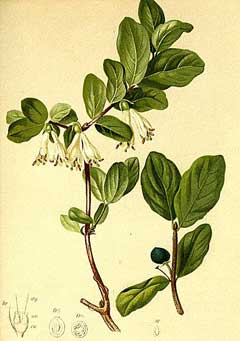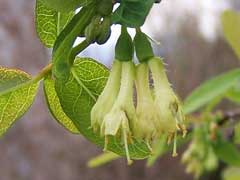 |
|
http://commons.wikimedia.org/wiki/File:Lonicera_caerulea_Atlas_Alpenflora.jpg |
 |
| http://commons.wikimedia.org/wiki/User:Selso |
Translate this page:
Summary
Another member of the Honeysuckle family, Honeyberry or Haskapberry is a fast-growing deciduous shrub grown for its blueberry-like fruit. Although the berries are small, they are great eaten raw straight from the bush and fun to graze with children. Most varieties have small green leaves and attractive stems. They are hardy to zone 3 and are easy-to-grow with no pest or disease problems. Fruit can be eaten raw or used in jams and jellies. They can also be frozen for later use. High in antioxidants and vitamin C. Haskap are superior to any other Honeyberries with sweeter, wild Blueberry flavour and larger, fleshier fruit. Extremely cold hardy. Two varieties are needed for pollination. Note: Lonicera caerulea var. edulis Turcz. ex Herder is a synonym of Lonicera caerulea L.
Physical Characteristics

 Lonicera caerulea is a deciduous Shrub growing to 2 m (6ft 7in) at a fast rate.
Lonicera caerulea is a deciduous Shrub growing to 2 m (6ft 7in) at a fast rate.
See above for USDA hardiness. It is hardy to UK zone 2. It is in flower from April to May. The species is hermaphrodite (has both male and female organs) and is pollinated by Insects. The plant is not self-fertile.
Suitable for: light (sandy), medium (loamy) and heavy (clay) soils. Suitable pH: mildly acid, neutral and basic (mildly alkaline) soils. It cannot grow in the shade. It prefers moist soil.
UK Hardiness Map
US Hardiness Map
Synonyms
Plant Habitats
Woodland Garden Sunny Edge; Dappled Shade;
Edible Uses
Edible Parts: Fruit
Edible Uses:
The following report is for the closely related L. villosa, it would be worthwhile experimenting with this plant to check on edibility[K]. The fruit of this species is about 5mm in diameter[235]. Fruit - raw or preserved[43, 105, 200]. A milder flavour than most edible honeysuckles, they can be eaten raw but are mainly used in making jams, jellies and refreshing drinks[183].
References More on Edible Uses
Medicinal Uses
Plants For A Future can not take any responsibility for any adverse effects from the use of plants. Always seek advice from a professional before using a plant medicinally.
None known
References More on Medicinal Uses
The Bookshop: Edible Plant Books
Our Latest books on Perennial Plants For Food Forests and Permaculture Gardens in paperback or digital formats.

Edible Tropical Plants
Food Forest Plants for Hotter Conditions: 250+ Plants For Tropical Food Forests & Permaculture Gardens.
More

Edible Temperate Plants
Plants for Your Food Forest: 500 Plants for Temperate Food Forests & Permaculture Gardens.
More

More Books
PFAF have eight books available in paperback and digital formats. Browse the shop for more information.
Shop Now
Other Uses
References More on Other Uses
Cultivation details
Grows best in a good moist soil in a sunny position, it does not fruit so well in the shade[200]. Closely related to L. villosa[200]. Interesting botanically because it appears as though two flowers arise from a single ovary[11]. The fruit is actually a fleshy growth that surrounds the two ovaries[11]. A very variable species[11], there are some named forms selected for their ornamental value[200]. Plants of many haskap cultivars grow to be 1.5 to 2 meters tall and wide, can survive a large range of soil acidity, from 3.9-7.7 (optimum 5.5-6.5), requiring high organic matter, well drained soils, and plentiful sunlight for optimum productivity. Lonicera caerulea plants are more tolerant of wet conditions than most fruit species. In garden design, as well as the above-ground architecture of a plant, root structure considerations help in choosing plants that work together for their optimal soil requirements including nutrients and water. The root pattern is branching: a heart root, dividing from the crown into several primary roots going down and out [2-1].
References Carbon Farming Information and Carbon Sequestration Information
Temperature Converter
Type a value in the Celsius field to convert the value to Fahrenheit:
Fahrenheit:
The PFAF Bookshop
Plants For A Future have a number of books available in paperback and digital form. Book titles include Edible Plants, Edible Perennials, Edible Trees,Edible Shrubs, Woodland Gardening, and Temperate Food Forest Plants. Our new book is Food Forest Plants For Hotter Conditions (Tropical and Sub-Tropical).
Shop Now
Plant Propagation
Seed - best sown as soon as it is ripe in a cold frame. Stored seed requires 2 months cold stratification[113] and should be sown as soon as possible in a cold frame. When they are large enough to handle, prick the seedlings out into individual pots and grow them on in the greenhouse for at least their first winter. Plant them out into their permanent positions in late spring or early summer, after the last expected frosts. Cuttings of half-ripe wood, 7 - 10cm with or without a heel, July/August in a frame. Good percentage[78]. Cuttings of mature wood of the current season's growth, 15 - 20cm with or without a heel, November in a cold frame. Good percentage[78]. Layering in autumn[200].
Other Names
If available other names are mentioned here
Hascup, Hasukappu, honeyberry, haskap berry, blue-berried honeysuckle, or sweetberry honeysuckle
Native Range
Coming Soon
Weed Potential
Right plant wrong place. We are currently updating this section.
Please note that a plant may be invasive in one area but may not in your area so it's worth checking.
Conservation Status
IUCN Red List of Threatened Plants Status :

Growth: S = slow M = medium F = fast. Soil: L = light (sandy) M = medium H = heavy (clay). pH: A = acid N = neutral B = basic (alkaline). Shade: F = full shade S = semi-shade N = no shade. Moisture: D = dry M = Moist We = wet Wa = water.
Now available:
Food Forest Plants for Mediterranean Conditions
350+ Perennial Plants For Mediterranean and Drier Food Forests and Permaculture Gardens.
[Paperback and eBook]
This is the third in Plants For A Future's series of plant guides for food forests tailored to
specific climate zones. Following volumes on temperate and tropical ecosystems, this book focuses
on species suited to Mediterranean conditions—regions with hot, dry summers and cool, wet winters,
often facing the added challenge of climate change.
Read More
Expert comment
Author
L.
Botanical References
11200235
Links / References
For a list of references used on this page please go here
Readers comment